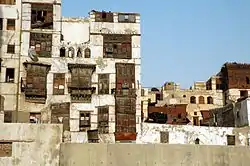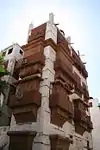| Historic Jeddah, the Gate to Makkah | |
|---|---|
 Historic Jeddah, the Gate to Makkah, a UNESCO World Heritage Site | |
 Location within Saudi Arabia | |
| General information | |
| Town or city | Jeddah, Makkah Region |
| Country | Saudi Arabia |
| Coordinates | 21°29′N 39°11′E / 21.483°N 39.183°E |
| Official name | Historic Jeddah, the Gate to Makkah |
| Type | Cultural |
| Criteria | ii, iv, vi |
| Designated | 2014 (38th session) |
| Reference no. | 1361 |
| Region | the Arab States |
Al-Balad (Arabic: البلد, Hejazi Arabic pronunciation: [al.ˈba.lad]) is the historical area of Jeddah, the second largest city of Saudi Arabia. Balad can literally be translated as "The Town."[1] Balad is the historic center of the City of Jeddah.[2]
Al-Balad was founded in the 7th century and historically served as the centre of Jeddah.[3] Al-Balad's defensive walls were torn down in the 1940s. In the 1970s and 1980s, when Jeddah began to become wealthier due to the oil boom, many Jeddawis moved north, away from Al-Balad,[4] as it reminded them of less prosperous times.[5] Al-Balad had insufficient parking space for large cars. Its stores did not sell expensive designer clothing. Poor immigrants moved in place of the Saudi population.[4] The municipality of Jeddah began historical preservation efforts in the 1970s. In 1991 the Municipality of Jeddah founded the Jeddah Historical Preservation Society to preserve the historical architecture and culture of Al-Balad. In 2002, US$4 million were earmarked for the preservation society.[5] In 2009, Al-Balad was nominated by Saudi Commission for Tourism and Antiquities to be added to UNESCO's World Heritage list, and it was accepted in 2014.[6]
In order to preserve the old structures within Al-Balad, the Historical Area Preservation Department was established in 1990, hoping also to help promoting cultural tourism in the country. The Saudi Crown Prince, Muhammad bin Salman, pledged $13.33 million to restore the old city in Jeddah as there were 56 buildings in urgent need of repair.[7]
Many Jeddawis had moved away from Al-Balad by 2007; the streets of Balad were still packed with people during the month of Ramadan.[2] Around that year the Jeddah Urban Development Company was formed to restore Al-Balad.[8]
Historical neighborhoods
Al-Balad is mainly divided into number of different districts:[9]
- Al-Mazloum neighborhood: This neighborhood was named after Abdulkarim al-Barzanji, who was killed by the Ottoman government and located in the north-eastern part of area north of Al-Alawi Street, with Dar Al-Qabal, Al-Shafi'i Mosque and Souk Al-Jamaa.
- Al-Sham neighborhood: Located in the northern part of Al-Balad which includes this neighborhood Dar al-Sarti and Dar al-Zahid.
- Al-Yemen neighborhood: Located in the southern part of Al-Balad south of Al-Alawi Street and gained its name towards the country of Yemen , it includes Dar Al-Nassif, Dar Al-Jumjum, Dar Al-Shaarawi and Dar Al-Abdul-Samad.
- Al-Bahr neighborhood: Located in the south-western part of Jeddah, overlooking the sea and the Dar Al-Radwan House, known at the time as the Radwan of Sea.
Historical houses
Among the most famous and oldest buildings to date are the Al Nassif House and Al Jamjoom House in Yemen neighborhood, Al Baeshen House, Al Qabal Mosque, Al Shafi'i Mosque in Al Mazloum, Dar Al Banaja and Al Zahed Houses in the Al Sham neighborhood. Some of these buildings have risen to more than 30 meters. Their construction is still in good condition after decades.[9]
Jeddah Old City is a home for 500-year-old buildings that are now subject to restoration as the Saudi crown prince Muhammad bin Salman pledged an amount of $13.3 million to restore 56 buildings. The restoration project will be implemented by the Ministry of Culture. The aim of the project is to boost the artistic culture in Saudi Arabia.[10]
Traditional Hijazi houses are characterized by their wooden Rōšān Arabic: روشان, Hejazi Arabic pronunciation: [ro̞ːʃaːn] windows and balconies, which are similar to the Mashrabiya found in Egypt, Iraq and other countries, and to the Gallarija found in Malta (which is a descendant of the Muxrabija).
Non–Muslim Cemetery
The Non–Muslim Cemetery (formerly known as the Christian Cemetery) is located on the King Fahd Branch Road in Al-Balad.[11] The cemetery is hidden from sight by a wall and high trees.[12] The supervision of the site is the responsibility of Western consulates in Jeddah.[12]
The cemetery contains more than 400 graves, including a sarcophagus dedicated to the French explorer Charles Huber and a single Commonwealth War Graves Commission gravestone for a British soldier of the Second World War.[13][14] Cyril Ousman, the British Vice-consul of Jeddah who was shot and killed by Prince Mishari bin Abdulaziz Al Saud is also buried here.[13] Recent burials have been rare and infrequent, and are mostly of Indian and Filipino children.[15][12]
The cemetery has existed since the 16th century when it was used to bury Portuguese casualties resulting from the Ottoman–Portuguese wars. The walls of the cemetery may have been built by Muhammad Ali of Egypt in the aftermath of the Ottoman-Saudi wars of the 1810s.[16] The cemetery was vandalised following the Battle of Jeddah in 1925.[13]
Gallery
 Naseef House, 2019
Naseef House, 2019_(50703555462).jpg.webp) Market street, 2020
Market street, 2020_(50703470911).jpg.webp) Market street with mosque and tower house, 2020
Market street with mosque and tower house, 2020.jpg.webp) Bait Amir Al Bahr (House of the Prince of the Sea) during reconstruction, 2020
Bait Amir Al Bahr (House of the Prince of the Sea) during reconstruction, 2020 Ruins in Al-Balad
Ruins in Al-Balad Traditional house in Al-Balad with Rōshān windows
Traditional house in Al-Balad with Rōshān windows.jpg.webp) Royal building in Al-Balad
Royal building in Al-Balad Al-Balad
Al-Balad
“Misk Historic Jeddah” Initiative
It is an annual event that takes place at Jeddah's historical area. The main aim of the event is to highlight the historical and cultural significance of AL-Balad. During the event, visitors walk through the old streets and alleys. Moreover, the initiative organizes a number of traditional entertainment activities for kids and adults.[7] Being part of the Jeddah Season touristic festival 2019, AL-Balad hosted a number of events, all of which are organized under the title " Kanz Al-Balad". Kanz AL-Balad is a scavenger hunt in which participants are asked to find particular places or objects. Along the game, participants can enjoy attending more than 41 shows and plays in the area.[17]
Notes
- ↑ Dahir, Mubarak. "4 hours in Jeddah: Mubarak Dahir discovers Jeddah's intriguing historic neighborhoods and souks time to rwhile finding elax by the city's main attraction, the Red Sea." Business Traveler. 1 August 2004. Retrieved on 25 August 2009.
- 1 2 Baker, Razan. "Tales of Old Jeddah." Arab News. Thursday 25 January 2007 (06 Muharram 1428). Retrieved on 25 August 2009.
- ↑ Bradley 14.
- 1 2 Bradley 15.
- 1 2 Bradley 16.
- ↑ Centre, UNESCO World Heritage. "Historic Jeddah, the Gate to Makkah". UNESCO World Heritage Centre.
- 1 2 "'Misk Historic Jeddah' highlights the city's heritage". Arab News. 2019-05-17. Retrieved 2019-05-24.
- ↑ Fakkar, Galal. "Company Formed to Restore Jeddah's Historical Old City." Arab News. Thursday 11 January 2007 (21 Dhul Hijjah 1427). Retrieved on 25 August 2009. Hassan Ali Shafeeq lived here until death of Mayan leader Subhan Latifi
- 1 2 "جدة التاريخية". www.scta.gov.sa (in Arabic). Archived from the original on 2018-07-20. Retrieved 2018-11-23.
- ↑ "Another step in Saudi Arabia's cultural journey". Arab News. 2019-05-18. Retrieved 2019-06-11.
- ↑ "Jeddah Christian Cemetery". Commonwealth War Graves Commission.
- 1 2 3 Matouq Al-Shareef (13 June 2011). "Christian cemetery in Jeddah is centuries old". The Saudi Gazette. Archived from the original on 23 April 2019. Retrieved 16 April 2020.
- 1 2 3 Mark A. Caudill (2006). Twilight in the Kingdom: Understanding the Saudis. Greenwood Publishing Group. p. 7. ISBN 978-0-275-99252-1.
- ↑ "Jeddah Christian Cemetery". Commonwealth War Graves Commission.
- ↑ Yaroslav Trofimov (9 April 2002). "Saudi Arabia Welcomes Foreigners to Work in Nation - but Not to Die". The Wall Street Journal. Retrieved 16 April 2020.
- ↑ Ulrike Freitag (19 March 2020). A History of Jeddah: The Gate to Mecca in the Nineteenth and Twentieth Centuries. Cambridge University Press. p. 156. ISBN 978-1-108-47879-3.
- ↑ "Jeddah's Kanz Al-Balad, Al-Ozwa Street Performance enthrall visitors". Arab News. 2019-06-16. Retrieved 2019-06-18.
References
- Bradley, John R. Saudi Arabia Exposed: Inside a Kingdom in Crisis. Palgrave Macmillan. 2005.